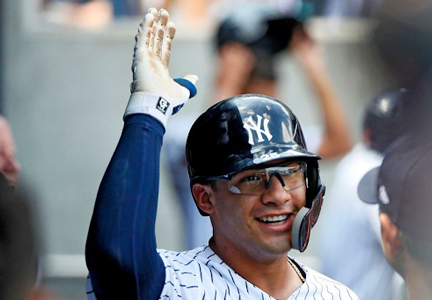
By Linda Conlin, Pro to Pro Managing Editor
That’s what Yankees teammates shouted to shortstop Gleyber Torres after he homered and drove in four runs to help the Yankees win over the Blue Jays September 9, while he was wearing sport glasses. Since then, Torres is batting .500 and vows to continue to wear the glasses. As eyecare professionals, we think that he is playing better because he can see better, but that doesn’t seem to be the case. The glasses are nonprescription and appear to have a light tint, although Torres wears contact lenses. Are the glasses really helping?
Torres said he used the glasses last year and hit well, that he “feel(s) really good with the glasses,” and they are “good luck.” Is it only superstition? We know ballplayers who have rituals and talismans that they believe bring them luck. For example, Miguel Andujar did his eye black counterclockwise for this game and Tyler Wade changed the music in his headphones pregame, but glasses? Do the glasses give Torres confidence, or do they help him feel more protected at the plate? We can only speculate, and we Yankees fans hope he keeps them on for the rest of the season.
Torres’ hitting streak aside, crediting sport glasses with his success is a great example for his fans. Amateur athletes, especially youngsters, may be more willing to embrace sport glasses as a tool to improve their game. We ECPs, however, value protection over prowess. According to the National Eye Institute, baseball is a leading cause of eye injuries among children 14 years old and younger who play sports in the U.S., and sadly, 90% of those injuries could have been prevented by using protective eyewear. Eye injuries attributed to baseball include corneal abrasion, orbital fracture, hyphema, which is an accumulation of blood in the anterior chamber that can lead to glaucoma, ruptured eyeball, cataract, and detached retina.
While many youth sports teams shut down for the spring and summer, fall ball leagues are trying to make the most of what’s left of the season. It’s still important to remind not only parents, but coaches that protective eyewear is a necessary part of the sporting equipment arsenal. And if a little more encouragement is needed, tell them that “Glasses Gleyber” says they are a game changer.
Know how to guide the sports enthusiast to the best lens and frame for comfort and visual performance with our CE, Mapping a Course for Growth with Sports Performance Eyewear, at 2020mag.com/ce. This course is free, courtesy of an educational grant from Rudy Project.











